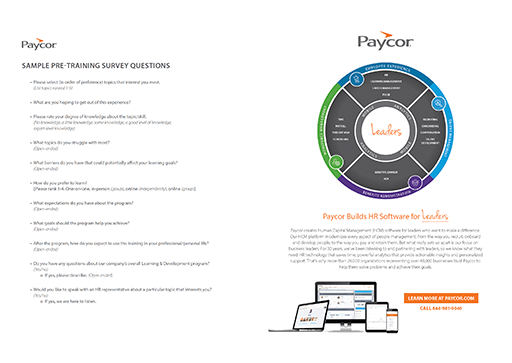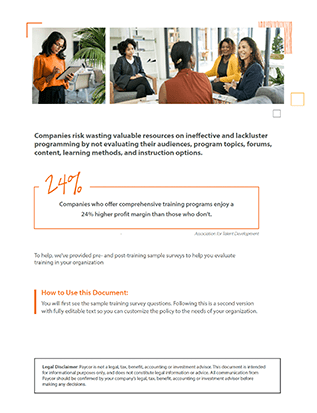Training Survey Questions: How to Know if Your Training Programs are Effective
- Companies who offer comprehensive training programs enjoy a 24% higher profit margin than those who don’t.
- Conducting pre- and post-training surveys can provide valuable information about the programs’ ultimate success, failure, and value.
- More than simply gathering data, it is essential to analyze and glean as much information as possible from surveys
We all know that learning and development are critical to a company’s long-term growth. Companies that offer comprehensive training gain a 24% higher profit margin than ones that don’t (Forbes). But there’s a catch. The workplace training your company offers must be good. Seems obvious, but it’s so easy to roll out ambitious learning and training sessions and then never follow up to gauge the result. A survey can be a great way to capture important data, and if you know how to analyze the results and glean actionable insights from what you learn, you’ve got a winning strategy. To help you get started, we’ll share pre and post-training survey questions. Feel free to use them as-is or edit to fit the needs of your organization.
Why Conduct a Training Evaluation Survey?
The insights from training surveys can guide learning and development program decision-making and help build action plans that build goodwill, create opportunities and provide an improved return on investment (ROI). Surveys can inform leadership teams if there are:
- Opportunities to upskill employees
- How to amend programs
- Untapped project ownership and strategic moves
- Connections that foster growth or address issues
- Co-working and mentorship opportunities
- Better ways to manage time, attention, costs
- Employees who can share knowledge and testimonials
- Changes and innovations to support
- Practical elements that are missing from current learning and development programs
- Confidence boosters and reward systems that the company can put into place to support employees
Pre-Training Questionnaire
Some of the work to evaluate your training courses will need to happen before you even begin training. This is often done with pre-training questionnaires. Pre-training surveys can help you understand the participants’ expectations, and their learning styles and preferences. The answers to the questions can help leaders understand how a person learns, goals, expectations and how well a topic is already understood. Additionally, the most important question that should be asked is: What are you hoping to get out of this course? This specific data can help you guide objectives and measure success after training is complete.
Types of questions in Pre-Training Feedback Surveys
Here are some examples of the types of open-ended questions that appear on pre-training questionnaires:
- What expectations do you have about the program? (Open-ended)
- What learning goals should the program help you achieve? (Open-ended)
- How do you prefer to learn?
For the full list, download our template.
Post-Training Questionnaire
Once employees participate in a program, it is critical to evaluate its value while still fresh in the participants’ minds. Conducting a post-training effectiveness survey within the first 24 hours will help HR and other leaders better understand the employee’s experience and determine whether a program should be repeated in its current form or modified. Post-training surveys can also provide feedback about the instructor/mentor from their level of knowledge and enthusiasm to their presentation skills. HR leaders need to know the value of their programs relative to business objectives and employee engagement.
Types of questions in Post-Training Feedback Surveys
Here are some examples of the types of open-ended questions that appear on pre-training questionnaires:
- Did you learn anything new (Yes/no)
- Do you have any suggestions to improve this course? (Yes/no)
- Did the training content meet your expectations? (Yes/no)
For the full list, download our helpful template.
Utilizing Post-Training Effectiveness Survey Feedback
By now you understand how pre- and post-training surveys work, and why HR leaders must continuously gather data about employee satisfaction; but the most important step is implementing the data to improve programs and processes. More than simply gathering data, it is essential to analyze and glean as much information as possible from surveys, even if respondents are anonymous. Responses can determine and benchmark how knowledgeable, trained, and engaged your staff is and what modifications or improvements need to occur to help make the company successful. Make a plan to adapt your program to the needs of your audience based on their preferred learning experiences.
Use Information to Inform Action
Understanding the effectiveness of training and development programs is critical to every company’s long-term growth strategy investment. Therefore, HR and company leaders need help to make sound, data-driven decisions about the programs, products, and services they offer and to whom. Conducting pre- and post-training surveys can help drive selections, simplify and define curriculum content, and provide valuable information about the programs’ ultimate success, failure, and value.
When leaders make grounded decisions with employees’ input in mind, employees feel trusted and heard. Paycor’s Pulse survey software empowers leaders to go beyond the traditional annual survey to seek employee sentiment, evaluate honest feedback, and develop an agile action plan that builds goodwill and increased ROI.
Learn more about Paycor Pulse.











